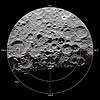 |
Paris - Nov 20, 2003 The spacecraft is now in its 102nd orbit and has been functioning very well since the last anomaly occurred on November 5. SMART-1 has now operated flawlessly for more than 12 days. The spacecraft was operated in electric propulsion mode almost continuously, only interrupting it during the eclipses where the power available from the batteries cannot sustain the high demand of the engine. As a precaution we were also keeping the engine off until the orbit altitude was more than 10 000 km. The total cumulated thrust time is now more than 663 hours and we have consumed about 10.5 kg of Xenon fuel. Moreover, the electric propulsion engine performance, periodically monitored by means of the telemetry data transmitted by the spacecraft and by radio-tracking by the ground stations, has shown in the last period a stable slight over performance in thrust of about 1.5%. We are presently increasing the semi-major axis at a rate of about 150 km per day. Due to the electric propulsion system's excellent performance and the decreased radiation environment, we are now planning to extend the thrust to altitudes below 10 000 km. The electric power produced by the solar arrays continues to be affected, as expected, by the radiation environment. We continue to register on average a loss of less than 2 Watts per day. This degradation should last until the trajectory crosses the radiation belts, i.e. for another month. At this rate the solar arrays will have lost about 130 W at the exit of the radiation belts. Due to the built in power margins, this will allow the spacecraft to continue thrusting at full power, hence shortening the time envisaged to reach the Moon. Of course, this is provided that we won?t get another exceptional solar storm again soon. The communication, data handling and on-board software subsystems have been performing very well in this period. The thermal subsystem continues also to perform well and all the temperatures are as expected. The only item of concern is still the temperature of one of the star tracker optical heads which is slightly too high (>10 �C) during part of the orbit at perigee and apogee. The star trackers have become more sensitive to temperature, due to the aging produced on the CCD by the massive radiation dose received in the last weeks. This has caused many momentary loss of attitude determination by that star tracker, about 200-300 times per day for an average time of 2 seconds. This is without consequences, as there is another star tracker, which provides good attitude determination and the system is anyway capable of coping without both star trackers for much longer periods of time. Nevertheless, thermal engineers are still looking into the possibilities to reduce the temperature of the star tracker optical heads. Another glitch occurred when the star tracker probably lost time synchronisation for a short while, which was enough to trigger an internal alarm. This however did not produce any effect as it lasted for too short. Apart from the above problem of the star trackers, the attitude control subsystem continues to work very well in general. Presently only the two diagnostic plasma instruments (EPDP and SPEDE) are being regularly operated. New operations with the other instruments are being studied and will be implemented as soon as a good opportunity will arise. In the next period we plan also to use the electric propulsion cathode B, which has not been commissioned yet. Other tests on redundant units are also planned to be executed as soon as possible. From the start, the electric propulsion system has managed to increase the semi-major axis of the orbit by 4083 km, increasing the perigee altitude from the original 656 km to 4466 km and the orbital period by more than two and a half hours, from the initial 10 hours 41 minutes to the present 13 hours 27 minutes. Email This Article
Related Links  Arecibo - Nov 13, 2003
Arecibo - Nov 13, 2003Despite evidence from two space probes in the 1990s, radar astronomers say they can find no signs of thick ice at the moon's poles. If there is water at the lunar poles, the researchers say, it is widely scattered and permanently frozen inside the dust layers, something akin to terrestrial permafrost. |
|
| The content herein, unless otherwise known to be public domain, are Copyright 1995-2006 - SpaceDaily.AFP and UPI Wire Stories are copyright Agence France-Presse and United Press International. ESA PortalReports are copyright European Space Agency. All NASA sourced material is public domain. Additionalcopyrights may apply in whole or part to other bona fide parties. Advertising does not imply endorsement,agreement or approval of any opinions, statements or information provided by SpaceDaily on any Web page published or hosted by SpaceDaily. Privacy Statement |